Scotiabank SCENE
Events, Seasonal and Short-Term (BRONZE)
Client Credits: Scotiabank
Duncan Hannay, SVP, Head of Marketing Canadian Banking
Jeff Marshall – VP Marketing and Brand Management, Scotiabank
Carolyn Saunders – Director and Head, Brand Management and Creative Development, Scotiabank
Agency Credits: Bensimon Byrne Inc.
Joseph Bonnici – Creative Director
Chris Harrison – Associate Creative Director, Bensimon Byrne
Hayes Steinberg – Associate Creative Director
Sandi Truffen – Director of Client Services
Jessica Mills, Account Director
Natalie Taylor – Project Manager
Katie O’donovan – Project Manager
Christine Pacheco – Producer
Michelle Pilling – Director of Production Services
Section I — BASIC INFORMATION
| Business Results Period (Consecutive Months): | June 1, 2012 – September 30, 2012 |
| Start of Advertising/Communication Effort: | June 18, 2012 |
| Base Period as a Benchmark: | November 2010 to September 2011 |
Section II — SITUATION ANALYSIS
a) Overall Assessment
Loyalty rewards programs, a key driver of share-of-wallet decisions for many Canadian consumers, are now considered table stakes in an increasingly saturated market. Canadians hold an average of 6.4 rewards cards with 92% of all Canadians being a member of at least one rewards program, and 78% shopping strategically to accumulate points.
In 2007 Scotiabank, in partnership with Cineplex Entertainment, launched the SCENE program, a movie loyalty reward program. Targeted at core frequent movie goers (18 to 34-year-olds); the SCENE program has consistently delivered customer and account growth for Scotiabank and helped to attract younger consumers to the bank. However, the SCENE program is largely attributed to Cineplex as their loyalty reward program, and low awareness of Scotiabank’s relationship or offerings, thus sales of the bank products (Scotiabank SCENE bank account and credit card) is a constant challenge.
In addition to awareness of Scotiabank’s products and value proposition, there is high inertia when it comes to peoples’ bank accounts with consumers generally not willing to go through the hassle of switching to a new bank account or acquiring a VISA card. For reference, SCENE debit and VISA cards allow consumers to earn points on their everyday purchases, redeemable for free movies, concessions and more thus allowing people to earn points more rapidly, versus the SCENE Black Card (a basic rewards card which is a joint venture between Scotiabank and Cineplex Entertainment) which only accumulates points for movie purchases.
The primary goal of the campaign was to increase enrolment in Scotiabank SCENE banking account and VISA products by increasing awareness of the Scotiabank product value proposition and infusing excitement into a low-engagement category.
The secondary goal was to increase propensity to consider Scotiabank as a primary banking destination overall.
While it was definitely going to be a challenge to get people to switch, the value of acquiring new day-to-day banking accounts made it well worth the effort. New day-to-day bank accounts allow Scotiabank to establish the “primary banking relationship” with new consumers. This relationship makes the task of selling other Scotiabank products to these individuals considerably easier.
To break through the clutter in the promotions-rich summer season, which included heavy marketing efforts by RBC during the London Olympics, Scotiabank needed to develop a campaign that appealed to this consumer segment on both a functional and emotional level.
b) Resulting Business Objectives
Based on the year-over-year growth which Scotiabank’s SCENE business had enjoyed since its launch in 2007, an aggressive business goal was set for this campaign. The primary business objective was to increase the total number of day-to-day banking accounts (SCENE debit cards) by a 6 to 12% incremental lift during the June 18th to September 10th in-market period for this campaign.
While not specifically-stated business goals, there was intent that this campaign would provide a halo for both SCENE Visa acquisition and increase Cineplex SCENE Black Cards. While Black Card acquisitions are not new customers to Scotiabank it has historically been a great vehicle for future Scotiabank prospects.
c) Annual Media Budget
Confidential
d) Geographic Area
Canada (except for Atlantic region)
Section III — STRATEGIC THINKING
a) Analysis and Insight
In an attention economy, there’s nothing more motivating to consumers than free. People love free, but are skeptical of it – they assume that something “free” will come with strings attached and want to feel like they’ve earned whatever they’re getting. When they feel they’ve earned it, free is a powerful reward – both functionally and emotionally.
This is particularly true for SCENE’s core target: Frequent-movie-going men and women ages 18 to 34. For many in this segment, rewards programs lose some of their appeal because of how long it takes to accumulate enough points to redeem for anything of value. The value proposition of the SCENE card, however, is simple – use your Scotiabank debit card for the things you purchase every day and earn free movies (1 point for every $5 spent).
Although toughest to sell, debit rewards are still relatively rare in the Canadian market and debit as a payment vehicle is appealing to a younger audience. We therefore chose to focus on the SCENE debit card as our lead message in Scotiabank’s mass marketing efforts. Developing a compelling and differentiated way to demonstrate the benefits of SCENE was critical to the success of this campaign. It wasn’t good enough to simply tell consumers about the promise of this rewards-based debit card (you may never have to pay for a movie again), we needed to show them and on a scale grand enough to make an emotional impact on our target.
b) Communication Strategy
The Financial Institution category is largely commoditized, due primarily to it being heavily-regulated, making it difficult for banks to offer distinct competitive advantages in terms of offerings or messaging. And the FI rewards card market remains true to that. Every rewards card commoditizes itself by talking about numbers. The most miles, more seats, a certain amount of cash back, and so on. This has led to different brands trying to outshout and outdo each other with their offers. As a result of this, consumers have generally shut down to the messaging as the assumption, which is generally accurate, is that everything is more-or-less the same.
With SCENE we recognized we had a completely different and proprietary product which allowed us to stay away for the sea of sameness that is numbers-related communications. Instead of focussing solely on what kind of offer came with the card, we focussed on a richer value proposition for our consumers. Our communications reminded the target about their passion for movies and linked it back to how they could love going to the movies even more if, by simply using the SCENE card for their everyday purchases, they might never have to pay for a movie again.
Section IV — KEY EXECUTIONAL ELEMENTS
a)Media Used
|
MASS |
SOCIAL/DIGITAL |
|
Television
|
Facebook contest to drive engagement
|
|
Cinema
|
Online Display ads
|
|
TSAs
|
Online
|
|
Branch
|
YouTube
|
|
On-Campus Posters
|
|
b)Creative Discussion
The campaign centred on a single, unifying idea rooted in “you’re richer than you think”. A movie is a rich, emotional experience – a free movie even more so. The external expression of that? Richness Is: The Feeling of Free.
What better way to illustrate that than treating unsuspecting moviegoers to a free night at the movies?
To bring SCENE’s value proposition to life, we bought out a multiplex – every seat, bag of popcorn, box of candy and drink – for the premiere of “The Avengers”. Since communications which are truly authentic is a key pillar of Scotiabank’s marketing strategy, we didn’t hire actors or let moviegoers in on the surprise right away.
We positioned 20 hidden cameras at all points of purchase. When moviegoers went to pay for tickets or to order snacks, they were told their transaction would be free. Reactions ranged from suspicion to confusion to pleasant surprise. We finally let the moviegoers in on what was happening when, before the film started, we let them know, via the big screen, that Scotiabank was behind their free night at the movies. This was met by a big round of applause.
From the footage we acquired throughout the night at the multiplex, we developed two TV spots and two pre-roll videos which allowed Scotiabank to share the rich experience with a much broader audience. Out-Of-Home, print and Point-Of-Sale executions focused on contextual in-theatre moments, with lines ranging from “Richness Is: 120 minutes of escape” (mass) to “Richness Is: A 2-hour study break” (student-targeted).
Scotiabank hosted a daily movie ticket giveaway on Facebook, creating a connection between offline and online tactics by driving consumers to the contest via NFC chips on transit shelters – a first for a Canadian Financial Institution.
The digital buy for this campaign also included innovative Xbox and Connected TV placements that allowed us to reach our target in contextually relevant ways.
c)Media Discussion
N/A
Section V — BUSINESS RESULTS
a) Sales/Share Results
The SCENE campaign delivered record business results for Scotiabank, significantly increasing acquisition for the SCENE debit card. While not a stated business objective at the outset of the campaign, the VISA acquisition numbers for this time period were also very strong. Additionally record numbers for the SCENE basic rewards card were also delivered.
July 2012 saw the highest-ever monthly acquisition in the program’s 5-year history for both debit card and Visa. August then eclipsed July’s numbers with 24.3% and 39.8% increases over the previous month’s acquisitions for debit card and Visa respectively.
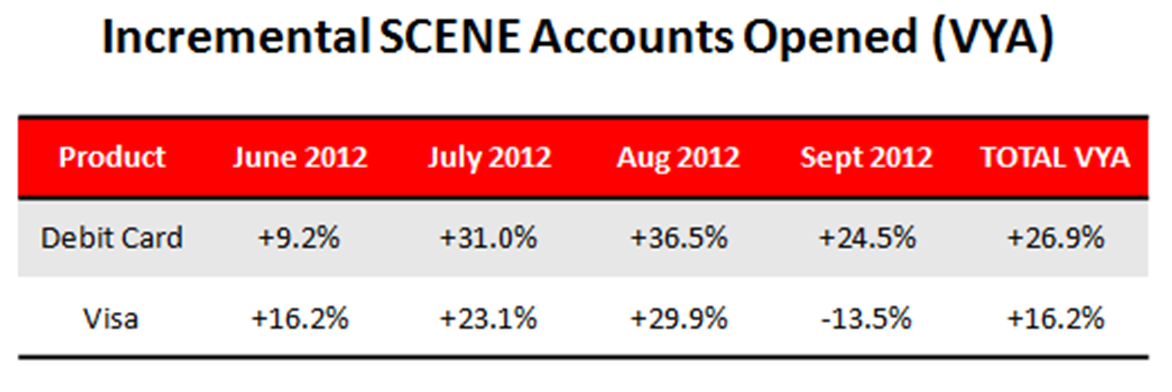
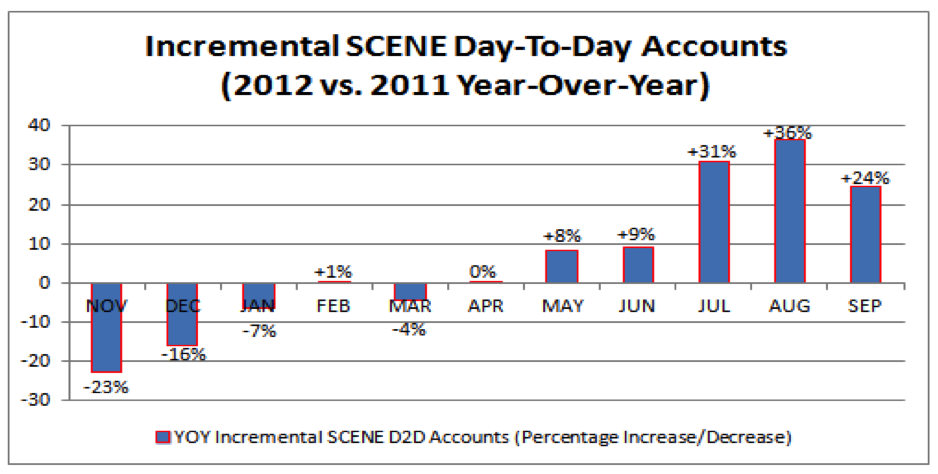
Of note, the strongest acquisition months for the SCENE debit card were July and August. The campaign ran for the entirety of these two months. June and September also experienced significant year-over-year growth however those months perhaps saw smaller growth due to the fact that the SCENE campaign only ran during roughly ten days of each month.
Also worth noting, 79% of new SCENE debit card accounts were opened by coveted new-to-bank customers. This is important as if the campaign only converted existing customers the campaign would have effectively increased costs of Scotiabank’s existing customers, without adding any incremental revenue as the SCENE rewards is free with the bank account.
Finally, the campaign was also successful in attracting younger customers to the bank with 69% of new day-to-day accounts during this time period coming from people under the age of 35.
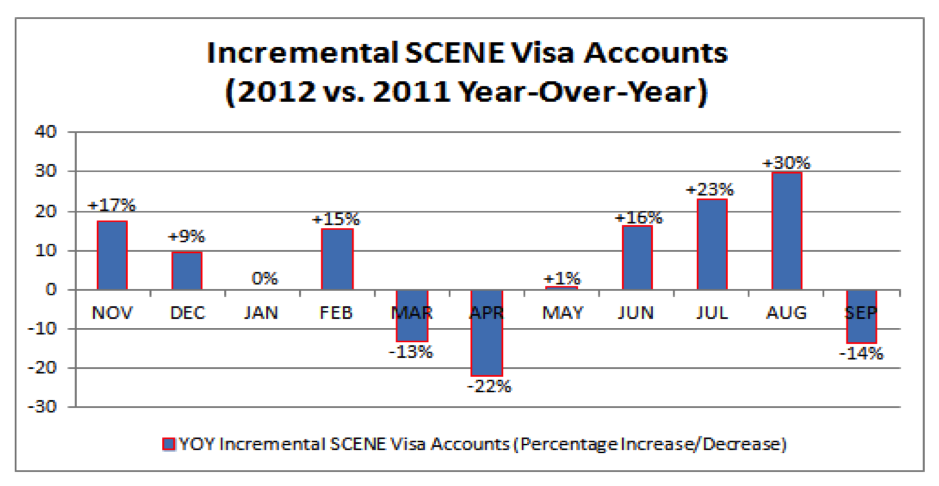
Visa, similar to debit card, saw the strongest acquisition numbers when the SCENE campaign covered the entire month (July and August).
In addition to very strong new-customer-acquisition numbers, the SCENE Black Card had record enrolments during the campaign with July 2012 experiencing the highest-recorded monthly enrolment ever. The average monthly acquisition for the campaign period was 49.9% higher than the average from the previous seven months.
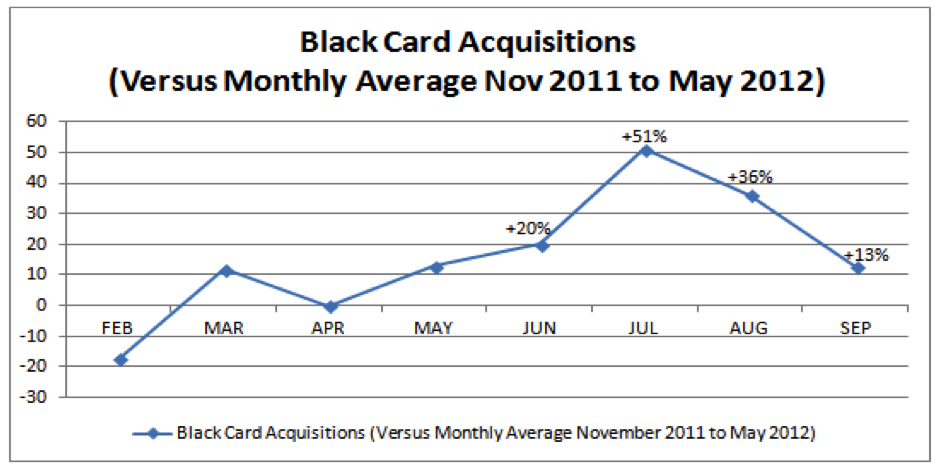
b) Consumption/ Usage Results
c) Other Pertinent Results
d) Return on Investment
Section VI — CAUSE & EFFECT BETWEEN ADVERTISING AND RESULTS
a)General Discussion
The key factors to determining the relationship between the advertising and the performance can be attributed to Awareness (Prompted Recall and Brand Link) measures and Business Results Impact.
The first step in proving the relationship between advertising and business results is to demonstrate that the advertising was impactful. We show this correlation by looking at advertising in market tracking results and its ability to break through and correctly attributed to Scotiabank.
Overall both SCENE TVCs (“Full Audience” and “Woman Guest”) broke through well above Ipsos’ norms and were linked back to Scotiabank at above-norm levels. The results were even stronger with the campaign’s primary target: Frequent Moviegoers between ages 18 to 34.
“Full Audience”: Prompted Recall with Frequent Moviegoers and 18 to 34-year-olds scored well above Ipsos’ Norms (+33.3% and +14.3% respectively). The spots were also well-branded with Frequent Moviegoers and 18 to 34-year-olds correctly recalling the Scotiabank brand well above Ipsos’ Norms (+80.0% and +68.0% respectively).
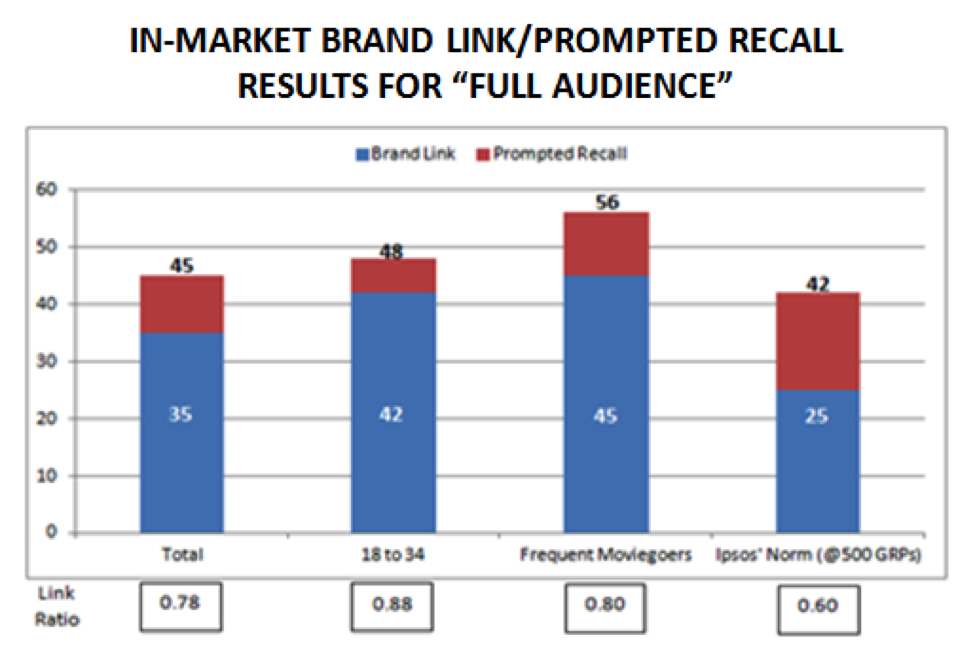
“Woman Guest”: Prompted Recall with Frequent Moviegoers and 18 to 34-year-olds scored even higher above Ipsos’ Norms than with “Full Audience” (+60.0% and +25.7% respectively). The spots were also well-branded with Frequent Moviegoers and 18 to 34-year-olds correctly recalling the Scotiabank brand well above Ipsos’ Norms. (+150.0% and +100.0% respectively).
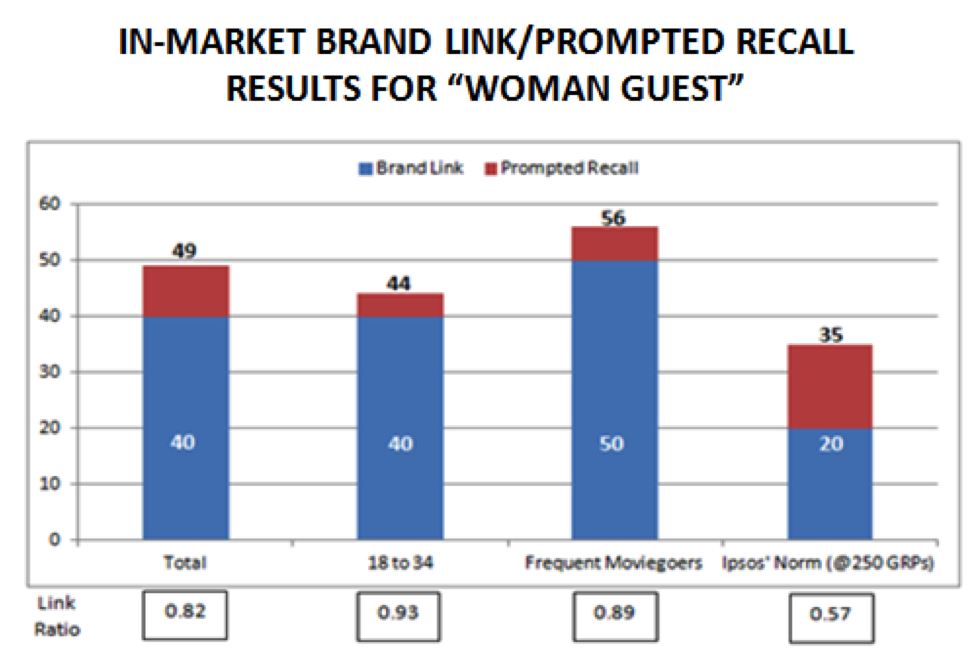
Another way Scotiabank increased levels of engagement in the Scotiabank proposition was to leverage the social media space. Scotiabank created a SCENE Facebook contest to engage users with a daily Cineplex movie ticket giveaway which supported Scotiabank’s SCENE debit card’s value proposition – “the feeling of free”.
BUSINESS IMPLICATIONS
Brand Link and Prompted Recall for both TV commercials scored high, social engagement was strong and propensity numbers headed in the right direction, so the critical question is did the advertising specifically drive results. It most certainly did. Scotiabank had what were considered aggressive business objectives for debit card acquisition for this campaign (6 to 12% incremental lift). That goal was eclipsed in particular during the 2 full months when the campaign was active (which at +31.0% and +36.5 VYA were record months). These results came on the heels of 7 previous months with either negative or flat growth in day-to-day acquisition (VYA).
A direct correlation between the SCENE campaign and the strong acquisition results for both Day-To-Day and Visa can be made when Prompted Recall numbers from the past several campaigns, including SCENE, is plotted against VYA increases/decreases in acquisition.
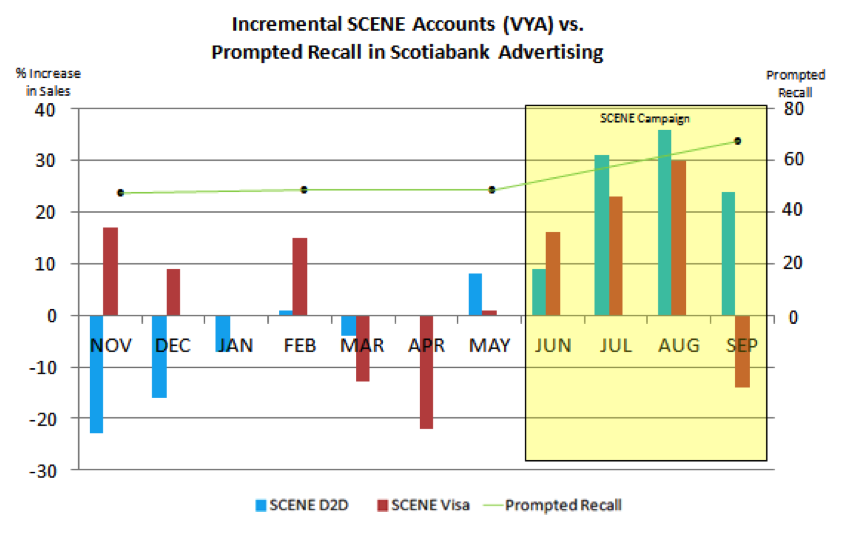
In addition to the record day-to-day results the halo effect of the campaign saw a +16.2% increase (VYA) in VISA accounts and well-above-average acquisition numbers for the SCENE Black Card.
b)Excluding Other Factors
Spending Levels:
N/A
Pricing:
N/A
Distribution Changes:
N/A
Unusual Promotional Activity:
N/A
Other Potential Causes:
N/A
N/A